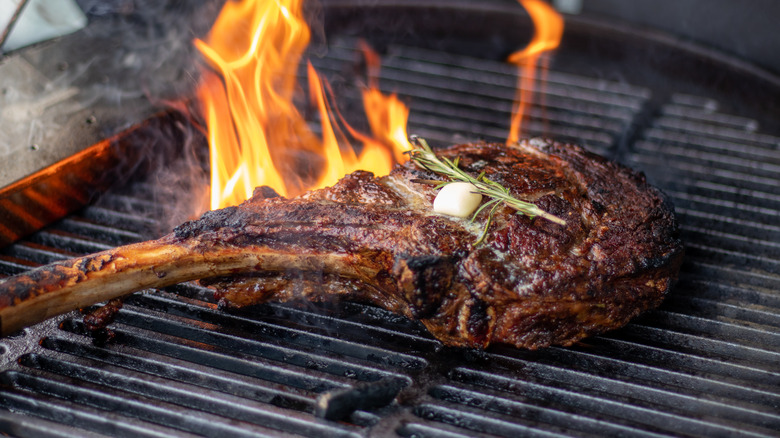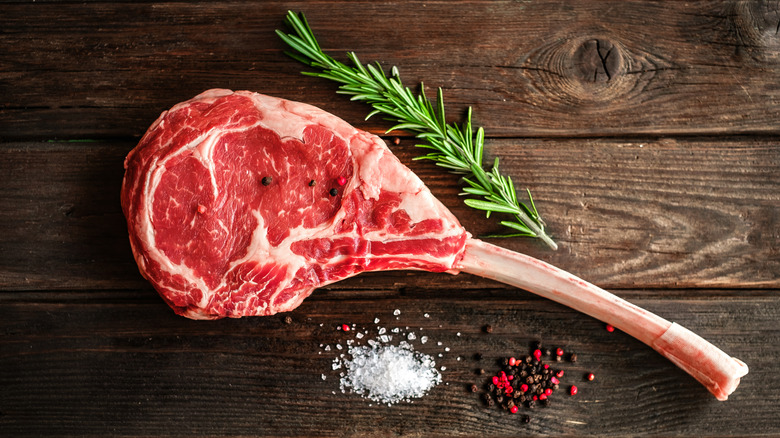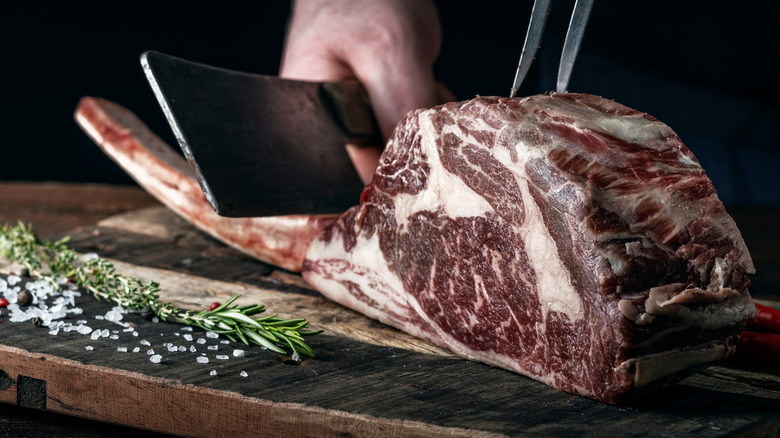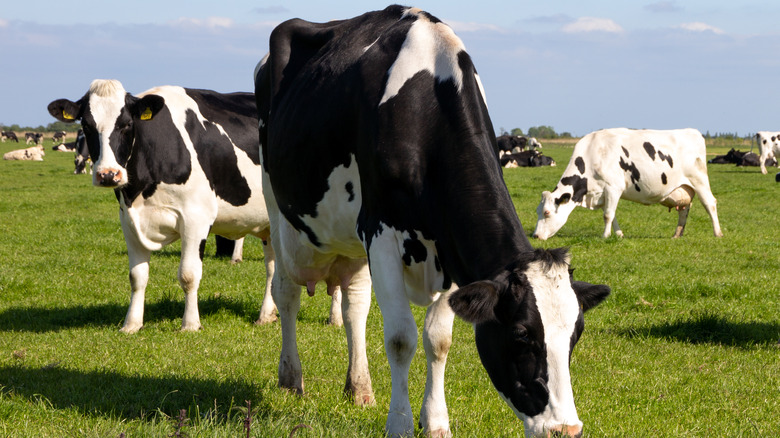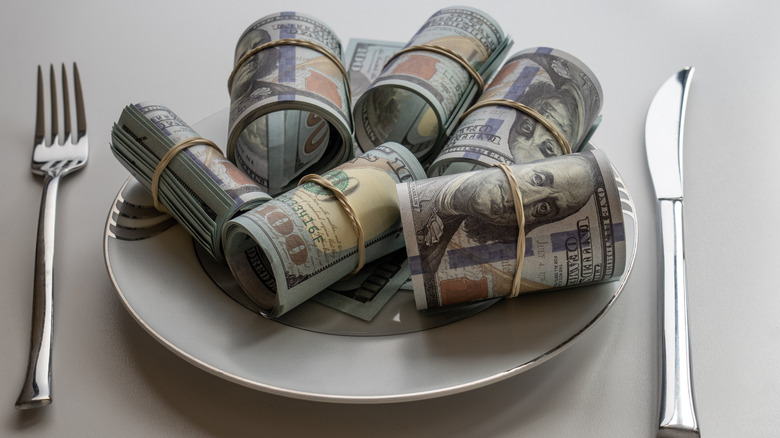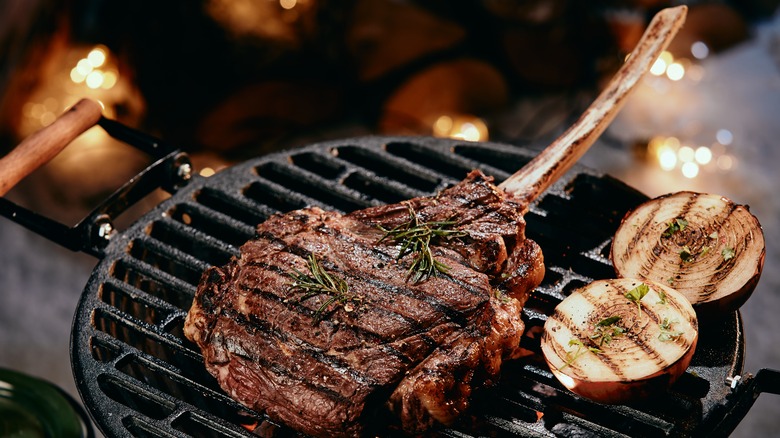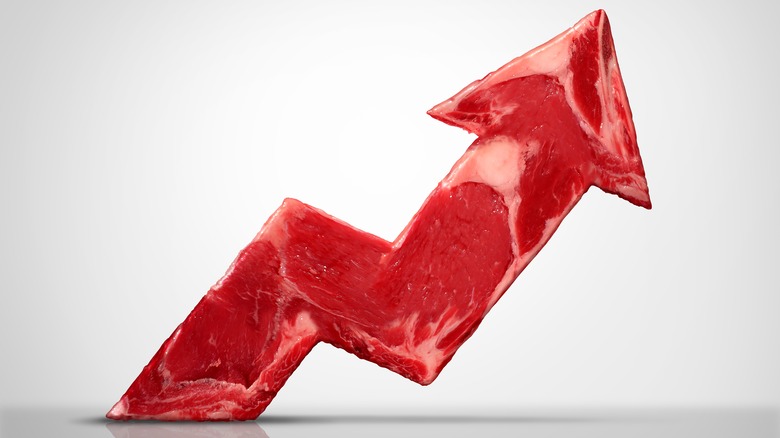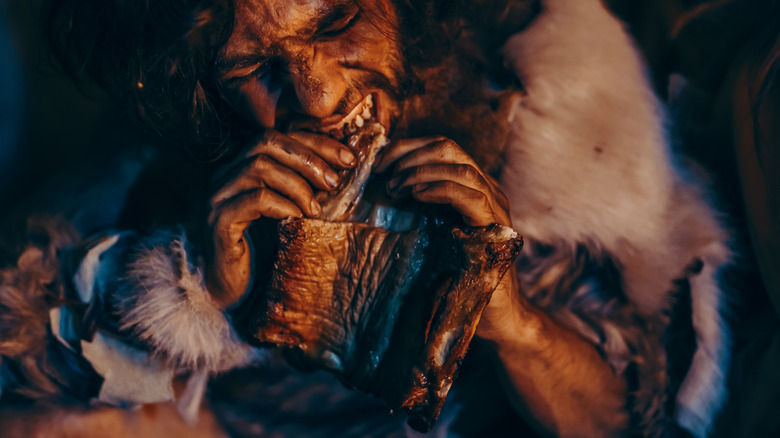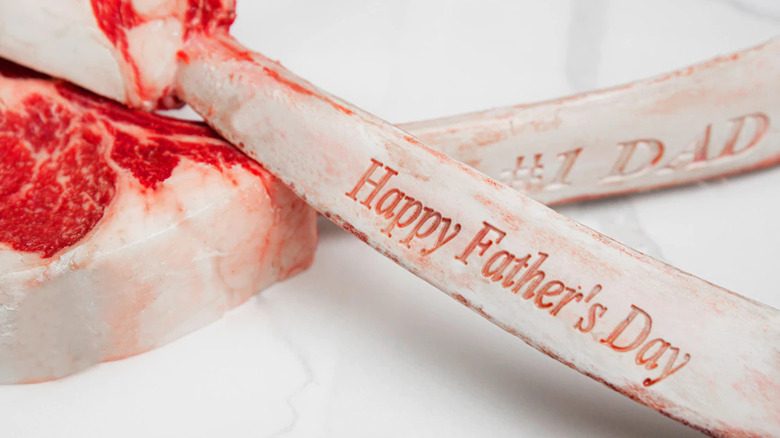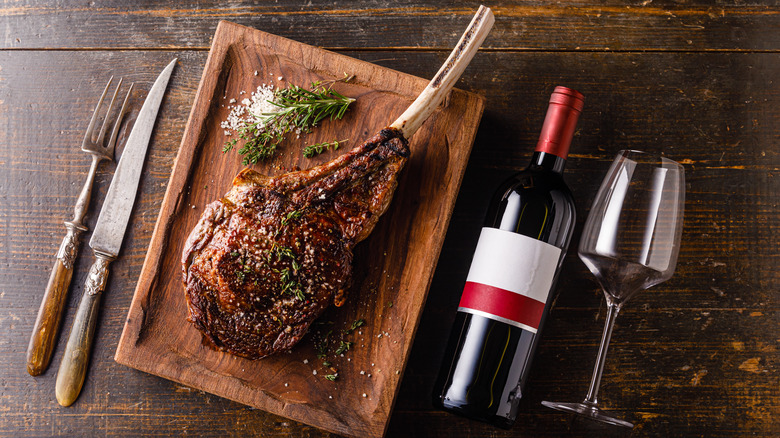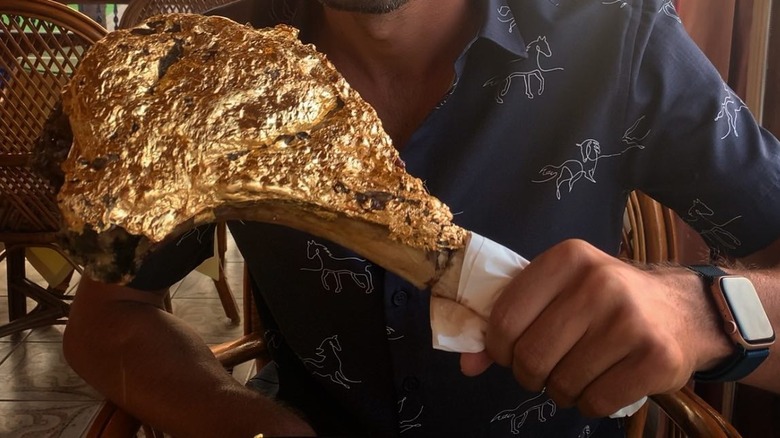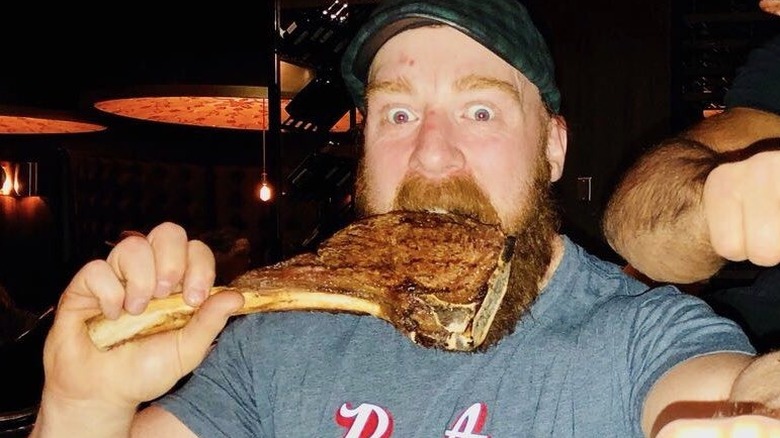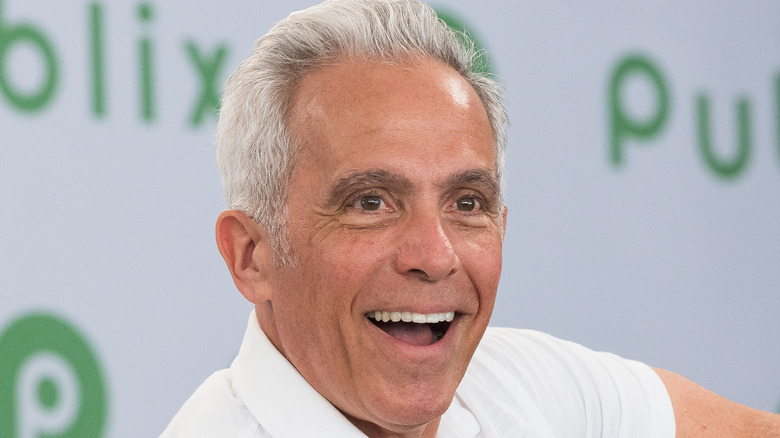The Untold Truth Of Tomahawk Steak
Beef. It's what's for dinner, right? For many in the United States and around the world, it certainly is. Whether it's grilling marinated steak tips in the summer, carving a perfectly roasted prime rib during the holidays, or splurging at a high-end steakhouse for special occasions, there's no denying humans' widespread love for all things beef.
And when you want a truly decadent, larger-than-life cut of beef, none may top the tomahawk steak. The tomahawk steak, so nicknamed for its uncanny resemblance to the traditional Native American tool (via Ruth's Chris Steakhouse), is truly epic. It's so epic, in fact, that it was the featured entree protein on the "Epic Eats" episode of "Chopped" (Season 36, Episode 5).
But beyond the Fred Flintstone aesthetic appeal, what makes the tomahawk steak so intriguing? What is a tomahawk steak, exactly? How is its signature style achieved? Why is it so expensive, and is it really worth the hype? Let's dig into this extravagant cut of beef, and explore some of the untold truths of the tomahawk steak.
A tomahawk steak is just another name for a bone-in ribeye
While the name may throw people off, the tomahawk steak is simply a bone-in ribeye (according to Certified Angus Beef). This incredibly tender, highly marbleized cut of beef is essentially a regular ribeye steak that hasn't had the bone removed. The long, intact rib bone is crucial to a Tomahawk steak, given its resemblance to an axe handle, and generally measures at least five inches (but can be much longer) as a result (via How Stuff Works).
Beyond the bone being left in, there are other distinguishing factors between a regular ribeye and a tomahawk steak. Unlike regular ribeyes, which have no set size or portion expectations, tomahawk steaks are traditionally at least two inches thick, and sold in portions ranging from 30-45 ounces. These eye-popping characteristics help set the tomahawk steak apart from boneless ribeyes, and other premium, high-quality steaks.
Additionally, "tomahawk" is just one of the steak's many colloquial nicknames. Depending on where you're ordering a tomahawk steak, it may be known locally as a "cowboy steak," a "côte de boeuf," or a "Delmonico steak." Of course, the name attached the the meat doesn't diminish the quality or taste, because, like a rose? A tomahawk steak by any other name is still just as mouth-watering.
The signature bone look is created using a technique called frenching
While the sheer size and heft of a tomahawk steak is bound to capture one's attention, its signature feature has to be the long bone that jets outward like a handle. But the exquisitely displayed bone doesn't come out of the cow looking that way. Rather, the clean, restaurant-ready look is achieved through a traditional food preparation technique known as "frenching."
Frenching is a classic culinary cleaning technique where all excess fat, meat, or other tissue is removed from the exposed bone in a cut of meat. This food preparation method is used to elevate any bone-in protein to a higher level of fine dining, and is the same technique that gives a rack of lamb its sophisticated appearance.
The presence of a perfectly frenched bone is crucial to a steak being classified as a tomahawk. After all, the attention-grabbing bone is a huge part of the steak's allure, and what makes it resemble the titular tool. Plus, without frenching, you wouldn't be able to pick up a tomahawk steak with such ease and comfort (and you probably wouldn't want to), as the bone would remain a flesh-covered mess.
Tomahawk steaks come from rarely-used rib muscles of a cow
The tomahawk steak comes from the longissimus dorsi muscle, which is the same part of the cow that t-bone and porterhouse steak cuts come from (according to Ruth's Chris Steakhouse). This muscle group is located along the posterior region of a cow, running along the rib cage of a cow's upper back. The specific muscles that are used to make tomahawk steaks lie underneath the ribs (via Smoked BBQ Source), and are cut from the rib primal of a cow, usually between ribs 6-12.
Given their location, these muscles are rarely used by the cow, and are heavily laden with intramuscular fat as a result. The liberal interspersing of fat within these muscle groups is what gives a tomahawk steak its almost perfect level of marbling, and results in the meat having an especially flavorful taste, as described by Omaha Steaks. The cow's lacking use of its longissimus dorsi muscle is also what gives a Tomahawk steak its incredible, melt-in-your-mouth tenderness.
Tomahawk steaks are incredibly expensive
Besides the signature bone handle and its incredible girth, the most well-known aspect of a tomahawk steak may be its hefty price tag. Since tomahawk steaks are at least two inches thick, with a protruding, perfectly-frenched bone, they're big and bold by design.
Consequently, Tomahawk steaks aren't cheap, and are often among the most expensive cuts of steak on the market. The average cost per pound for tomahawk steaks can run anywhere from $50 to $100, depending on the butcher or vendor. And since most Tomahawk steaks are sold in quantities of at least 30 ounces, an entire tomahawk steak can end up costing several hundred dollars in some cases (such as a 36-ounce tomahawk steak by Omaha Steaks, which was sold for $200 as of March 2022).
In fact, as recently as 2017, the most expensive cut of beef in the entire world was an aged tomahawk steak (or, more precisely, a côte de boeuf). Sold by acclaimed French butcher, Alexandre Poulmard, this "vintage 2000" cut of beef was sold for a whopping $3,200 per steak!
The bone helps insulate the steak while cooking
While some prefer a boneless cut of beef for ease of eating, the bone in a tomahawk steak is much more than just a fancy decoration or helpful handle. It also helps insulate the meat while cooking, allowing for a more evenly cooked steak than its boneless cousins (according to Kitchn).
Leaving the bone in a tomahawk steak allows it to cook slower, and reduces the risk of it drying out during the cooking process. This means there's less chance of ruining the meat while cooking, and let's be honest: if you're going to spend $100 or more for a steak, you might as well help your odds of cooking it perfectly. A dried out steak is disappointing — a dried out tomahawk steak is absolutely heart-breaking.
Additionally, some believe the bone in a tomahawk steak provides a richer overall flavor than the boneless alternative. This is because the marrow from within the bone is thought to seep out during cooking, enhancing the taste of the surrounding meat. It's unclear, though, whether any marrow is actually released when a steak cooks, and there is some debate amongst diehard steak fans over the perceived value of bone-in steaks versus boneless (according to Serious Eats).
Some don't believe the tomahawk steak is worth the price
As with all great things, the consensus opinion on tomahawk steaks is far from universal. Some are of the belief that the tomahawk steak is nothing more than empty hype, and a classic case of myth overtaking reality. "It's more about aesthetics than anything," said chef, Michael Puglisi, of Electric City Butchers (via Foodbeast).
Perhaps the strongest, and loudest, argument against the tomahawk steak relates to the undeniable weight added by the bone. While some insist the bone is necessary to maximize a tomahawk steak's flavor, others believe it's simply a marketing ploy. Since a tomahawk steak often costs twice as much as its boneless alternative (via Medium), some speculate that as much as half of the weight in a tomahawk steak can be attributed to the bone. And since it's usually priced by the pound, it's obvious why this may bother some meat-loving customers.
Whether or not the tomahawk steak can be classified as a rip-off depends completely on your personal preference. After all, you eat with your eyes before your mouth, and even the most ardent opponent of the tomahawk steak can admit: The look and presentation of a perfectly cooked tomahawk steak is absolutely mind-blowing.
Tomahawk steaks appeal to humans' caveman instincts
We love beef here in the United States — that shouldn't come as a surprise. The average American consumed 54.5 pounds of beef per year as recently as 2011 (according to the USDA). Even with a reported 70% price increase in beef in March 2021, many future brides and grooms were willing to eat that cost just to ensure their wedding had a beef or steak option on the menu (according to Boston.com).
This unabashed desire for all things beef and meat is a big reason why the tomahawk steak is so beloved. There's something primally enticing about a giant piece of cooked cow muscle, with the long rib bone still attached. There's no pretending or distancing yourself from what you're eating when you eat a tomahawk steak — and that's all part of the fun.
According to History.com, humans' general love of beef can be traced back more than two million years. Humans have an inherent desire to pursue and consume animal flesh, which is largely rooted in evolution. After all, ancient humans weren't buying fancily-packaged meat from a grocery store or placing orders at high-end restaurants. They were killing, scavenging, and butchering dead animals just to survive: blood, bones, flesh, and all.
We may not need meat or beef to survive, but we still often crave it. And when your caveman (or woman) instincts kick in, and you want a meal that resembles the rack of ribs that tips over the Flinstone family car during the show's opening credits? Nothing may satiate that instinctual, evolutionarily-derived craving like a tomahawk steak.
You can buy an engraved tomahawk steak as a present
Since the long, frenched bone of a tomahawk steak is its signature calling card, one American butcher, Pat Lafrieda, has gone all-in on its aesthetic ability. Noting "it's just such a striking piece of beef," (via Bloomberg) Lafrieda not only sells tomahawk steaks through his website. He also offers tomahawk steaks that include a custom-engraved message on the frenched bone.
After noticing one of his employees was an artist, Lafrieda inquired whether that employee would be able to carve an engraving onto a tomahawk steak's bone. Learning it was possible, he collaborated with the employee to design and create a line of products that were simultaneously art and beef.
Lafrieda introduced the product as a gimmick for Valentine's Day in 2021, offering tomahawk steaks with "I Love You" engraved on the bone. After that initial campaign, the engraved tomahawk steak was added to Lafrieda's website. Now, consumers have the option of purchasing a custom-engraved tomahawk steak to mark any special occasion, whether it's "Happy Birthday," "Happy Father's Day," or "Happy Eating."
Tomahawk steaks are often shared rather than eaten individually
Tomahawk steaks are considered an ideal steak to be eaten by more than one person (according to Omaha Steaks). Tomahawk steaks have been described by Ruth's Chris Steakhouse as the "perfect steak to share with two people," and Iron Chef Geoffrey Zakarian has stated a single tomahawk steak "can feed ... three people."
The price and size of a tomahawk steak are at the crux of this belief. After all, a tomahawk steak is sold, on average, for $100 or more (via Smoked BBQ Source), and is generally sold in 30-45 ounce quantities. Sharing a tomahawk steak with one or more people helps drastically reduce the budget-breaking cost, and decreases the chances you'll fall victim to the dreaded meat sweats.
While you're certainly more than welcome to channel your inner Joey Chestnut and go to town in carnivorous delight, your digestive system (and wallet) may be more forgiving if you split this steak with another person (or two). It all comes down to what your stomach (and wallet) can handle.
You can purchase a 24-karat gold wrapped tomahawk steak
If you're looking to further indulge with your already indulgent tomahawk steak, you may want to consider the Nusr-Et Restaurants. The chain of upscale restaurants, owned and operated by chef Nusret Gökçe (AKA the famous "Salt Bae" from social media fame), offers diners a traditional tomahawk steak option, as well as a 24-karat gold encrusted tomahawk steak. This deliberately ostentatious menu item is prepared by wrapping a tasteless 24-karat gold leaf around a tomahawk steak. The gold leaf is for presentation purposes only, and adds no flavor to the steak.
In 2019, the regular version of the tomahawk steak cost $275 at the Miami location, while the cost of the 24-karat gold encrusted version came in at $1,000 (via Esquire Middle East). The price has only increased through the years, and, as of October 2021, the 24-karat gold tomahawk steak was sold at the London location for an astounding £1,450, or roughly $1,900 (according to Evening Standard)!
Since being put on the menu, this incredibly decadent entree has caused controversy, for more than just its price tag. In December 2019, a party at the Nusr-Et Miami location refused to pay for a pair of gold-encrusted tomahawk steaks, claiming they ordered the regular steaks, but were served the gold version. After police were called in, the diners begrudgingly paid the bill, as they had eaten the gold-encrusted steaks during their meal.
You can eat a tomahawk steak like a beef lollipop
One of the best things about tomahawk steaks is the frenched bone, which allows you to pick the steak up like a giant beef lollipop. And while they aren't sold at amusement parks or renaissance fairs, like turkey legs, tomahawk steaks do, in fact, have a history of being eaten straight from the bone, sans utensils (as noted by chef Darren McGrady).
According to legend, the steak earned one of its many nicknames, the "cowboy steak," because cowboys do pick up bone-in ribeye steaks by the bone, and eat them like a beef corn-on-the-cob. Whether or not cowboys of yore actually walked around the range munching on giant steaks for simplicity's sake is unclear. But the bottom line is you can eat a tomahawk steak while holding the bone like a handle (via Steak University).
Maybe you aren't supposed to play with your food, but when it comes to tomahawk steaks? That old rule should be put out to pasture. Because it's not a matter of whether you should order a tomahawk steak, grab it by the bone, and eat it like a caveman.
It's the simple fact that you can.
Celebrity chef Geoffrey Zakarian is a big fan of the tomahawk steak
While some chefs and butchers have questioned the hype surrounding the tomahawk steak, others remain dedicated fans. This includes celebrity and Iron Chef, Geoffrey Zakarian, who's described the "very rich" tomahawk steak as the "best steak in the business."
The acclaimed chef has been a vocal proponent of the tomahawk steak for some time. Zakarian has featured the item at several of his restaurants, including a dry-aged steak entree at his now-closed Beverly Hills restaurant, Georgie (a recipe he shared with Food & Wine). Once, in an Instagram post, he even asked whether anyone has "ever seen a cut of steak so beautiful" while preparing a set of tomahawk steaks.
Zakarian recommends chefs pre-season tomahawk steaks several hours before cooking, as well as re-seasoning just before. While seasoning any meat hours beforehand is something he "never tells people to do," the perennial "Chopped" judge believes the extremely thick tomahawk steak may require this extra cooking step to maximize its flavor.
